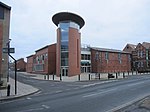Beverley Minster
BeverleyBuildings and structures in the East Riding of YorkshireChurch of England church buildings in the East Riding of YorkshireGothic architecture in EnglandGrade I listed buildings in the East Riding of Yorkshire ... and 4 more
Incomplete lists from August 2008Major Churches NetworkMonasteries in the East Riding of YorkshireUse British English from September 2013

Beverley Minster, otherwise known as the Parish Church of Saint John and Saint Martin, in Beverley, East Riding of Yorkshire, is a parish church in the Church of England. It is one of the largest parish churches in the UK, larger than one-third of all English cathedrals and regarded as a Gothic masterpiece by many. Originally a collegiate church, it was not selected as a bishop's seat during the Dissolution of the Monasteries; nevertheless, it survived as a parish church and the chapter house and the attached church of St Martin were the only major parts of the building to be lost. It is part of the Greater Churches Group and a Grade I listed building.
Excerpt from the Wikipedia article Beverley Minster (License: CC BY-SA 3.0, Authors, Images).Beverley Minster
Minster Yard North,
Geographical coordinates (GPS) Address Phone number Website External links Nearby Places Show on map
Geographical coordinates (GPS)
| Latitude | Longitude |
|---|---|
| N 53.839166666667 ° | E -0.42472222222222 ° |
Address
Beverley Minster
Minster Yard North
HU17 0DW
England, United Kingdom
Open on Google Maps










